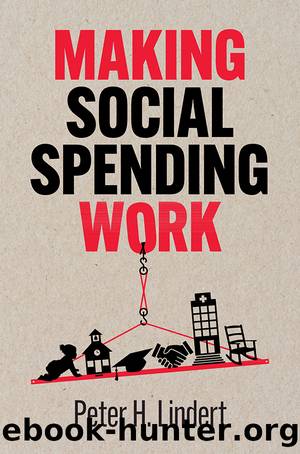Making Social Spending Work by Lindert Peter H

Author:Lindert, Peter H.
Language: eng
Format: epub
Publisher: Cambridge University Press
Published: 2021-01-05T00:00:00+00:00
Redistribution beyond the Short Run: Public Mass Education Equalizes Adult Incomes
These case histories illustrate a point that must be addressed by the emerging history of redistribution: Even if we restrict ourselves to fiscal redistributions, the effects of any one change in policy play out over many years, and cannot be captured by their seeming effects on rich and middle and poor within the same year. This yearâs social spending affects future pre-fisc inequality, i.e. the inequality of peopleâs incomes before taxes and transfer payments. Conventional measures of fiscal redistribution all miss the effects that play out over many years.
The three natural channels through which this yearâs policies affect future inequality are government treatment of non-human capital, deferred payment obligations such as public pensions, and government treatment of human capital. The first of these three channels has been well introduced by Thomas Piketty (2014), by Emmanuel Saez and Gabriel Zucman (2019), and by the larger PikettyâSaezâ-Zucman research program on capital and inequality. They are filling in the inter-temporal feedbacks whereby income and wealth taxation reduce this yearâs accumulation and future property incomes, especially for the very richest at the top of the distribution. The second of these three intertemporal channels, public pension obligations, will move to center stage in Chapters 12 and 13. Here, we turn to the third channel, the influences of public-schooling expenditures on future human capital.
A key implication of the mass-education effect will be that we have understated how much public education spending has cut income inequality over the last 150 years. The leveling of market incomes in the Great Leveling era from the 1910s to the 1970s was partly due to the hidden effect of rising public commitment to education, and the ominous rise of inequality since the 1970s would have been even worse without it. Far from explaining away part of the infamous rise of inequality since the 1970s, the fact that earlier outlays for public schooling must have leveled incomes, other things being equal, actually adds to the rise of inequality that still needs to be explained. After all, the continued convergence of adultsâ schooling should have left us with lower inequality, not higher.
The problem is that studies of fiscal redistribution typically count only the same-year effect of public subsidies to education. They have not treated the larger deferred effects. They include a same-year effect, as if the benefits of taxpayersâ paying for your (say) fifth-grade education accrue to your parents this year and not to you, the student, any time in the future. Convention has thus equated public education with day care. As convenient as this convention may be, it misses most of what public education spending does to the different income ranks.
Public spending on education affects the inequality of later market earnings and the progressivity of governmentâs contribution to reducing that inequality, through two channels. One is that lowering the inequality of adultsâ accumulated schooling, that global âconvergence, big timeâ revealed back in Chapter 5, should directly help to equalize their earnings for any given structure of pay rates.
Download
This site does not store any files on its server. We only index and link to content provided by other sites. Please contact the content providers to delete copyright contents if any and email us, we'll remove relevant links or contents immediately.
Managing Business Ethics by unknow(476)
Incentives and Prosocial Behavior by Incentives & Prosocial Behavior(392)
Reframing Difference in Organizational Communication Studies: Research, Pedagogy, and Practice by Dennis K. Mumby (editor)(336)
Financial Markets, Public Policy, and the East Asian Miracle by Financial Markets Public Policy & the East Asian Miracle(299)
The 21 Irrefutable Truths of Trading: A Trader's Guide to Developing a Mind to Win by John Hayden(264)
Handbook of Intercultural Communication and Cooperation (9783666403279) by Unknown(259)
Human Security in Turkey by Alpaslan Özerdem Füsun Özerdem(250)
How the World Became Rich: The Historical Origins of Economic Growth by Mark Koyama & Jared Rubin(241)
Fandom Analytics by Michael Lewis(239)
Guns of the World by Unknown(237)
Inheritance and Wealth Inequality in Britain by Harbury Colin;Hitchins David;(231)
Asset Integrity Management Systems a Complete Guide - 2020 Edition (9780655989844) by Blokdyk Gerardus(218)
Food Security, Affordable Housing, and Poverty by Ahmet Suayb Gundogdu(218)
Creative problem solving for managers by Developing Skills for Decision Making & Innovation(217)
Beyond Positivism, Behaviorism, and Neoinstitutionalism in Economics by Deirdre Nansen McCloskey(213)
The Way of the Wall Street Warrior by Dave Liu & Adam Snyder(211)
The Delusions of Economics by Gilbert Rist;(199)
Diminishing Returns by Mark Blyth(188)
The Inclusion Toolbox by Jennifer A. Kurth & Megan Gross(186)
